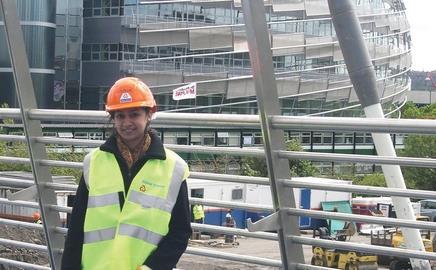Don’t have a BSc in construction? Don’t worry. Roma Agrawal’s first degree is in physics, but that hasn’t stopped her becoming one of the main engineers on a £4m project at the tender age of 23. She tells Jo Donnelly how it happened
How did you get involved in the Northumbria University footbridge project?
I joined WSP Group in London as a graduate about two years ago, working with a technical director. There were just two of us working on the £4m bridge, so I ended up as the main design engineer.
What did the role entail?
I started by doing a lot of calculations. The project was in its early stages, so we had flexibility in terms of structural form. I did some research on what the box girders and beam structure would be like, then created initial models on a software program.
As the project progressed, we started to work on the detailed design. We only had an architect up to the concept stage so we had to take the initiative and do a lot more work than we would have done normally. I went to meetings and co-ordinated landscape architects and contractors.
All site queries came to me and showed up areas that weren’t clear, so we had to do recalculations and sort the drawings out. I also looked after the drawings for the tender and construction stages. My day-to-day work changed at different stages of the project.
Did you find it strange having such an important role on your first project?
I wasn’t expecting it. You always hear that graduates join a big team and help out with design. I definitely learned a lot in a short space of time because I was working with a technical director, rather than in a bigger team with more junior people.
Why did you go into structural engineering?
I did physics at university because I wasn’t sure what I wanted to do, then did a masters in engineering later. Most people doing physics with me went into research or finance, but I didn’t want to do either. I wanted to do something technical, so I looked at different masters courses I could apply for.
The structural engineering one looked good – it was a one-year course and they said if your mathematical skills were OK, you’d be able to do it. It worked out quite well.
I didn’t have a huge idea what it would be like – I just knew I enjoyed the subject. People shouldn’t be scared of doing what they like at university and specialising later.
How did you find working on site?
I haven’t actually supervised a site yet because there was no engineer on the footbridge site, but I have been to look at things and solve problems a couple of times in the past few months. We’d go on site and the contractors would show us things that didn’t work properly. You’d have to come up with solutions on the spot, which I enjoyed.
Your next project is the 308m tall Shard in London. Will that be a big change?
The Shard’s different because it’s such a huge project. On the Northumbria bridge we were the only two designers on the project – on the Shard we’re a team of eight or nine. It’s a far longer project that’s already been going a few years, with another four years to go, so the speed at which things happen is a lot slower.
There’s a much larger volume of work on this scheme because it’s so high. If things change you have to go through the whole building, making sure everything’s sorted out. Things are starting to move – we’re starting on site quite soon.
With all that responsibility, do you find it hard to switch off when you go home?
The hours are quite good so I’m not working ridiculously late. Sometimes when things are important or I think I’ve done something wrong, I’ll wake up at night and think about checking them tomorrow, but you have to try to switch off and not worry about work.
When you started on the project, were you given any useful advice?
They said it’s better to ask questions if you’re not sure about something rather than design something and find out a month later, when it’s on site, that it was wrong. If you don’t know something, you should definitely ask.
Roma Agrawal’s CV
Age 23
Job Structural engineer at WSP Group
Projects Northumbria University footbridge (2005-2007); the Shard at London Bridge (from 2006)
Qualifications BA (Hons) physics, Oxford University; MSc general structural engineering, Imperial College London; IStructE, graduate member
Postscript
Network with young professionals at ∫√…´œ»…˙TV‚Äôs Phase One event in September. For details, go to

























No comments yet